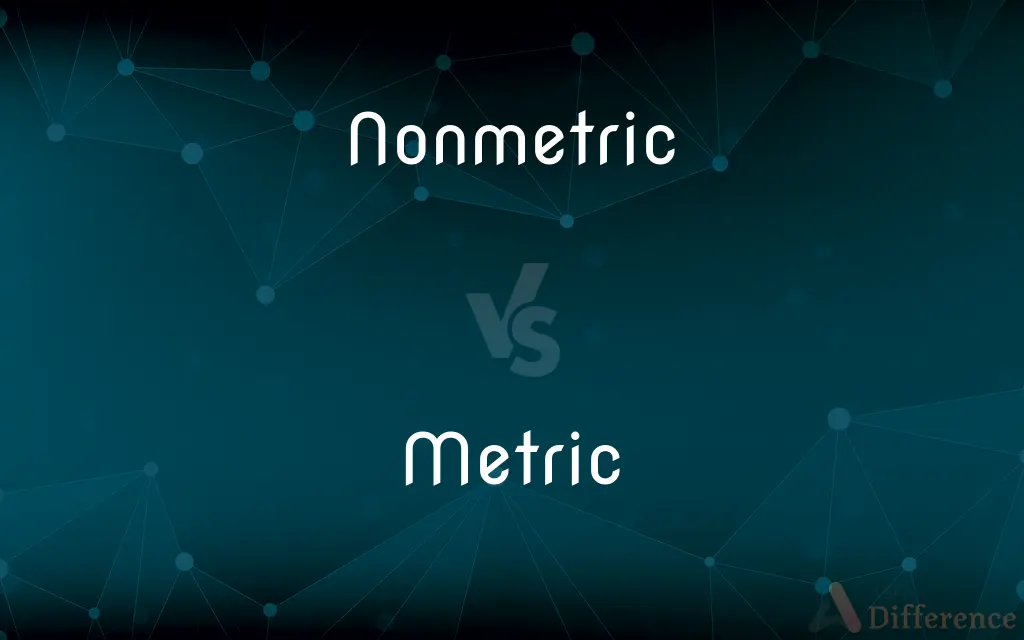Nonmetric vs. Metric — What's the Difference?
Edited by Tayyaba Rehman — By Urooj Arif — Updated on April 8, 2024
Nonmetric measures involve qualitative data analysis, focusing on categories and types, whereas metric measures are quantitative, emphasizing numerical values and units.

Difference Between Nonmetric and Metric
Table of Contents
ADVERTISEMENT
Key Differences
Nonmetric measurements are used in contexts where data classification is more about the type or category rather than quantity. These measurements are common in social sciences, where understanding patterns or behaviors does not always require numerical data. On the other hand, metric measurements are pivotal in the natural sciences, engineering, and areas requiring precise quantification, where measurements in standardized units like meters, kilograms, or seconds are essential.
Nonmetric methods often rely on ordinal or nominal scales, where data can be categorized but not quantitatively measured. For instance, a survey might classify customer satisfaction into categories like "satisfied," "neutral," or "dissatisfied." Metric measures, however, use interval and ratio scales, which means data can be expressed in terms of distance from a zero point, allowing for meaningful calculations and comparisons, such as temperature in Celsius or weight in pounds.
In nonmetric measurements, the focus is on understanding relationships or distinctions between groups or categories without assigning numerical values. This approach is useful in exploratory research or when the precise measurement is not possible or necessary. In contrast, metric measurements are about exact values and often involve calculations, analysis, and predictions based on these values, such as calculating the average height of a group of people or the speed of a car.
The analysis and interpretation of nonmetric data often involve qualitative methods, including thematic analysis or content analysis, which seek to identify patterns or themes within the data. Conversely, metric data analysis typically involves statistical methods, which can include complex calculations and models to understand trends, relationships, and cause-effect scenarios, emphasizing the importance of numerical precision and the ability to generalize findings.
While nonmetric measures are essential for capturing the depth and complexity of human experiences and perceptions, metric measures provide the accuracy and objectivity needed in many scientific and technical disciplines. Both types of measurements have their place, depending on the research question and the nature of the data being analyzed.
ADVERTISEMENT
Comparison Chart
Basis of Measurement
Qualitative data
Quantitative data
Common Uses
Social sciences, marketing
Natural sciences, engineering
Data Types
Categories, types
Numerical values, units
Scales Used
Ordinal, nominal
Interval, ratio
Analysis Methods
Thematic analysis, content analysis
Statistical calculations, models
Compare with Definitions
Nonmetric
Often used in qualitative research.
A study categorizing types of leadership styles in organizations.
Metric
Utilizes interval and ratio scales.
Measuring temperature in degrees Celsius.
Nonmetric
Involves non-quantitative analysis.
Analyzing interview transcripts to understand themes.
Metric
Essential in fields requiring precision.
Measuring chemical reactions in moles.
Nonmetric
Relating to data classified by category.
A survey categorizing films as either 'comedy' or 'drama'.
Metric
Data that can be accurately quantified.
Assessing a car's speed in kilometers per hour.
Nonmetric
Data that cannot be measured on a standard scale.
Classifying paintings by art movement.
Metric
Pertains to quantitative data analysis.
Calculating the average weight of a sample of apples.
Nonmetric
Pertains to ordinal or nominal data.
Ranking restaurants based on customer satisfaction levels.
Metric
Involves measurements in standard units.
Recording distances in meters.
Nonmetric
Not metric.
Metric
Of or relating to the metric system of measurement.
Metric
(music) Of or relating to the meter of a piece of music.
Metric
Of or relating to distance.
Metric
A measure for something; a means of deriving a quantitative measurement or approximation for otherwise qualitative phenomena (especially used in engineering).
What metric should be used for performance evaluation?
What are the most important metrics to track for your business?
It's the most important single metric that quantifies the predictive performance.
How to measure marketing? Use these key metrics for measuring marketing effectiveness.
There is a lack of standard metrics.
Metric
(mathematics) A function for the measurement of the "distance" between two points in some metric space: it is a real-valued function d(x,y) between points x and y satisfying the following properties: (1) "non-negativity": , (2) "identity of indiscernibles": , (3) "symmetry": , and (4) "triangle inequality": .
Metric
(mathematics) A metric tensor.
Metric
Abbreviation of metric system
Metric
To measure or analyse statistical data concerning the quality or effectiveness of a process.
We need to metric the status of software documentation.
We need to metric the verification of requirements.
We need to metric the system failures.
The project manager is metricking the closure of the action items.
Customer satisfaction was metricked by the marketing department.
Metric
Relating to measurement; involving, or proceeding by, measurement.
Metric
Of or pertaining to the meter as a standard of measurement; of or pertaining to the decimal system of measurement of which a meter is the unit; as, the metric system; a metric measurement.
Metric
A function of a topological space that gives, for any two points in the space, a value equal to the distance between them
Metric
A decimal unit of measurement of the metric system (based on meters and kilograms and seconds);
Convert all the measurements to metric units
It is easier to work in metric
Metric
A system of related measures that facilitates the quantification of some particular characteristic
Metric
Based on the meter as a standard of measurement;
The metric system
Metrical equivalents
Metric
The rhythmic arrangement of syllables
Common Curiosities
What is a nonmetric measurement?
Nonmetric measurement refers to the analysis and categorization of data based on types or categories, not on numerical values.
Can you give an example of a nonmetric scale?
An example of a nonmetric scale is a nominal scale, where data is categorized without a natural order, such as blood types.
What's an example of a metric scale?
An example of a metric scale is an interval scale, such as temperature measured in degrees Celsius, where each unit is equal and there is a meaningful zero point.
In which fields are metric measurements predominantly used?
Metric measurements are predominantly used in natural sciences, engineering, and any field requiring precise quantification.
How are nonmetric data analyzed?
Nonmetric data is often analyzed using qualitative methods such as thematic analysis or content analysis to identify patterns or themes.
How are metric data analyzed?
Metric data is typically analyzed using statistical methods and models to understand trends, relationships, and cause-effect scenarios.
In what fields are nonmetric measurements more common?
Nonmetric measurements are more common in social sciences, marketing, and qualitative research fields.
What is a metric measurement?
Metric measurement involves quantifying data using numerical values and standard units like meters, kilograms, or seconds.
Can a study use both nonmetric and metric data?
Yes, a study can use both nonmetric and metric data to gain a comprehensive understanding of a research question from both qualitative and quantitative perspectives.
What are the limitations of nonmetric measurements?
The limitations of nonmetric measurements include the potential for subjectivity and the difficulty in making broad generalizations from qualitative data.
What makes metric measurements critical?
Metric measurements are critical for ensuring accuracy, objectivity, and the ability to conduct meaningful calculations in scientific and technical research.
What is an example of using both nonmetric and metric measurements in a study?
A study on consumer behavior might use nonmetric measurements to classify consumer types and metric measurements to quantify their spending habits.
How do nonmetric and metric measurements complement each other in research?
Nonmetric and metric measurements complement each other by providing a deeper, more nuanced understanding of research topics, combining qualitative depth with quantitative precision.
Why are nonmetric measurements important?
Nonmetric measurements are important for capturing the depth and complexity of phenomena that cannot be quantitatively measured, especially in understanding human behaviors and preferences.
What are the limitations of metric measurements?
The limitations of metric measurements include the potential for overlooking the complexity and nuance of phenomena that cannot be easily quantified.
Share Your Discovery

Previous Comparison
Chill vs. Freeze
Next Comparison
Loner vs. LoserAuthor Spotlight
Written by
Urooj ArifUrooj is a skilled content writer at Ask Difference, known for her exceptional ability to simplify complex topics into engaging and informative content. With a passion for research and a flair for clear, concise writing, she consistently delivers articles that resonate with our diverse audience.
Edited by
Tayyaba RehmanTayyaba Rehman is a distinguished writer, currently serving as a primary contributor to askdifference.com. As a researcher in semantics and etymology, Tayyaba's passion for the complexity of languages and their distinctions has found a perfect home on the platform. Tayyaba delves into the intricacies of language, distinguishing between commonly confused words and phrases, thereby providing clarity for readers worldwide.














































